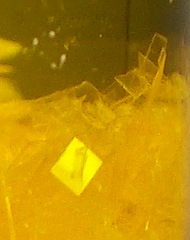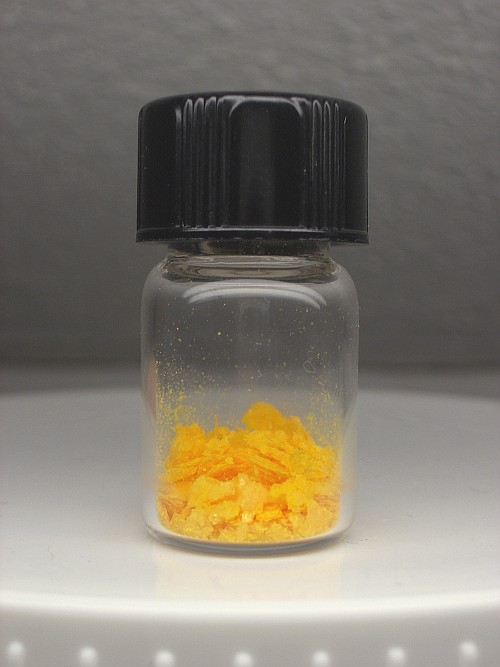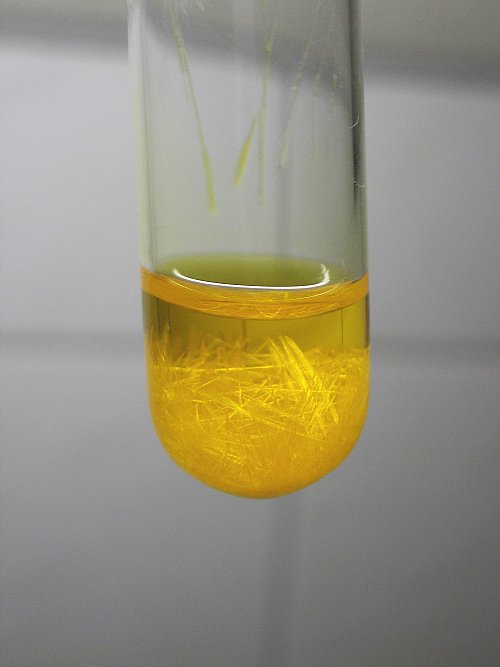


A polyhalide compound of rubidium
Halogens can form complexes with halide ions and these complexes can be fairly easily prepared. Isolating these compounds, however, only is possible when a large non-reducing cationic species is present. E.g. sodium polyhalides cannot be isolated, they simply decompose to plain sodium halide and the free halogen or interhalogen compound. With potassium ion, the same is true for all but a few polyhalogen compounds. With rubidium and cesium, these compounds however can be prepared and isolated in the solid state.
In this experiment, some rubidium chloride, dissolved in hydrochloric acid, is prepared and this is reacted with iodine trichloride in order to obtain the sparingly soluble RbICl4, which forms beautiful square crystalline plates.
![]()
![]() Required
chemicals:
Required
chemicals:
-
rubidium carbonate
-
iodic acid
-
hydrochloric acid (30%)
![]() Required
equipment:
Required
equipment:
- test tubes
- good quality filter paper (simple household tissue is not suitable)
![]() Safety:
Safety:
- Iodic acid is corrosive, avoid contact with skin. In case of contact, rinse well with a lot of water.
- Hydrochloric acid is corrosive and the concentrated liquid gives off nasty and corrosive fumes.
- In this experiment some free chlorine gas is produced. This gas is very toxic and corrosive. Do this experiment outside or in a very well ventilated room.
![]() Disposal:
Disposal:
- None of the compounds is particularly toxic or bad for the environment. Dilute all material with a lot of water and flush down the drain with more water.
![]()
Procedure for performing the experiment
![]() Take 100 mg of rubidium carbonate and add this to 4 ml of 30%
hydrochloric acid. This results in a lot of fizzling, carbon dioxide is formed.
The rubidium carbonate quickly dissolves and a clear and colorless solution is
obtained.
Take 100 mg of rubidium carbonate and add this to 4 ml of 30%
hydrochloric acid. This results in a lot of fizzling, carbon dioxide is formed.
The rubidium carbonate quickly dissolves and a clear and colorless solution is
obtained.
![]() Add 300
mg of iodic acid to the colorless liquid. This is a
fairly large excess amount. Theoretical amount, needed in the reaction is 152
mg, but quite some excess is needed for a successful preparation. Add this iodic
acid to the solution of rubidium carbonate in hydrochloric acid. When this is
done, then bubbles of chlorine gas are evolved, and a lot of a finely divided
yellow solid is formed.
Add 300
mg of iodic acid to the colorless liquid. This is a
fairly large excess amount. Theoretical amount, needed in the reaction is 152
mg, but quite some excess is needed for a successful preparation. Add this iodic
acid to the solution of rubidium carbonate in hydrochloric acid. When this is
done, then bubbles of chlorine gas are evolved, and a lot of a finely divided
yellow solid is formed.
![]() Carefully heat the liquid, such that all of the yellow solid
dissolves. As soon as all material has dissolved, stop heating. A clear and
golden yellow solution is obtained.
Carefully heat the liquid, such that all of the yellow solid
dissolves. As soon as all material has dissolved, stop heating. A clear and
golden yellow solution is obtained.
![]() Set aside the test tube with the golden yellow solution and
let it cool down slowly. On cooling down, beautiful thin square plates are
formed, which settle at the bottom. These plates are very beautiful and
large. Some of them are 3 mm2 and they look amazing. They also are
really thin, less than 0.1 mm. It is nice to simply watch the test tube, while
the crystals are formed and slowly settle at the bottom.
Set aside the test tube with the golden yellow solution and
let it cool down slowly. On cooling down, beautiful thin square plates are
formed, which settle at the bottom. These plates are very beautiful and
large. Some of them are 3 mm2 and they look amazing. They also are
really thin, less than 0.1 mm. It is nice to simply watch the test tube, while
the crystals are formed and slowly settle at the bottom.

 Some
of the crystals are so thin that they look transparent. Only the rims can be
seen. The crystals look very delicate. When the test tube is turned around
slowly, then you can see many glittering plates when the light is reflected into
the direction of your eyes. This effect also is captured in the close-up picture
given here.
Some
of the crystals are so thin that they look transparent. Only the rims can be
seen. The crystals look very delicate. When the test tube is turned around
slowly, then you can see many glittering plates when the light is reflected into
the direction of your eyes. This effect also is captured in the close-up picture
given here.
From just 100 mg of rubidium carbonate it is amazing to see how much of the test tube is filled with the crystal mass. This is misleading, because the crystals are very thin and a lot of liquid is trapped between the crystal plates. In reality most of the volume, which seems to be filled with crystal mass just is liquid between the crystal plates. Unfortunately, the delicate nature of these crystals only can be perceived as long as they are immersed in the liquid. When an attempt is made to isolate the solid material in a dry state, then this delicate structure is lost. The isolation of the solid compound is covered in the next section.
![]()
Isolation of solid RbICl4
Isolating the compound is not difficult at all. In the solution only the crystalline compound and volatile matter is present. A summary of all present species in solution:
- rubidium ions
- tetrachloro iodate(III) ions
- free iodine trichloride
- free chlorine
- hydrochloric acid
- water
So, isolating the solid just is a matter of getting as much as possible of the rubidium salt in the solid form and then drying it. All volatile matter evaporates, the salt remains behind.
![]() The first step in isolating the salt is putting the test tube
in a freezer, such that the liquid cools down much more and more of the solid
separated in the form of crystals.
The first step in isolating the salt is putting the test tube
in a freezer, such that the liquid cools down much more and more of the solid
separated in the form of crystals.
![]() When the
liquid is ice cold, then decant the liquid from the solid mass. Keep the solid
mass. The solid mass is very voluminous, a lot of liquid is trapped between the
crystals. Carefully tapping the test tube on a table after decanting the liquid
allows the crystal mass to collapse somewhat and more liquid can be decanted.
When the
liquid is ice cold, then decant the liquid from the solid mass. Keep the solid
mass. The solid mass is very voluminous, a lot of liquid is trapped between the
crystals. Carefully tapping the test tube on a table after decanting the liquid
allows the crystal mass to collapse somewhat and more liquid can be decanted.
![]() Next,
keep the test tube upside down and carefully tap it on a table, such that the
solid mass goes along the glass wall until it is near the open end of the test
tube. Do not let it slide out of the test tube.
Next,
keep the test tube upside down and carefully tap it on a table, such that the
solid mass goes along the glass wall until it is near the open end of the test
tube. Do not let it slide out of the test tube.
![]() Keep a
piece of good filter paper (not household tissue, that will suck in a lot of
crystals as well and it sticks to the crystal mass) just in contact with the wet
crystal mass. A lot of liquid is sucked into the filter paper through capillary
action.
Keep a
piece of good filter paper (not household tissue, that will suck in a lot of
crystals as well and it sticks to the crystal mass) just in contact with the wet
crystal mass. A lot of liquid is sucked into the filter paper through capillary
action.
![]() Tap the
now less wet solid mass into a petri dish. With a piece of good filter paper it
might be possible to remove a little bit more adhering liquid. Spread the solid
over the petri dish, such that it can be dried quickly.
Tap the
now less wet solid mass into a petri dish. With a piece of good filter paper it
might be possible to remove a little bit more adhering liquid. Spread the solid
over the petri dish, such that it can be dried quickly.
![]() Let the
crystals dry in a warm and dry place (40 to 50 °C) for a few hours. Perfectly
dry, non-hygroscopic material can be obtained, but do not dry for a longer
period than necessary. When the material is kept in contact with air, it slowly
looses ICl3 and finally after a few days, only RbCl is left.
Let the
crystals dry in a warm and dry place (40 to 50 °C) for a few hours. Perfectly
dry, non-hygroscopic material can be obtained, but do not dry for a longer
period than necessary. When the material is kept in contact with air, it slowly
looses ICl3 and finally after a few days, only RbCl is left.
The final result after drying is put in a small vial with a good corrosion-resistant cap which seals well.

The solid is golden yellow/orange. It is nice and dry, not sticky at all. The yield of this synthesis is 200 mg, which is 60% of theory. The remaining material is left in solution in the decanted liquid and in small crystals, which could not be tapped out of the test tube. This material also can be recovered, by allowing the liquid to evaporate in contact with warm dry air, but the resulting solid is less pure. It will also contain considerable amounts of RbCl. So, this second less pure crop of material should not be mixed with the first crop.
![]()
Comparison with properties of KICl4
A similar experiment was done with potassium iodate and concentrated hydrochloric acid:
Formation of KICl4 from KIO3 and HCl
In this experiment, the salt KICl4 is formed. This salt is much less stable than RbICl4. It looses ICl3 much more easily and soon only KCl is left behind. The shape of the crystals of KICl4 also is much different. The crystals of the rubidium salt are little square plates, the crystals of the potassium salt are long needles:

![]()
Discussion of results
![]() Rubidium carbonate dissolves in 30% hydrochloric acid, giving carbon dioxide and
rubidium chloride in solution.
Rubidium carbonate dissolves in 30% hydrochloric acid, giving carbon dioxide and
rubidium chloride in solution.
![]() When iodic acid is added to concentrated hydrochloric acid, then the iodine is
reduced from oxidation state +5 to oxidation state +3 and chloride is oxidized
to chlorine:
When iodic acid is added to concentrated hydrochloric acid, then the iodine is
reduced from oxidation state +5 to oxidation state +3 and chloride is oxidized
to chlorine:
HIO3 + 5H+ + 5Cl– → ICl3 + 3H2O + Cl2
Most of the chlorine escapes as gas from the liquid, the iodine trichloride dissolves in the liquid and leads to the golden yellow color of the liquid.
![]() The
iodine trichloride is in equilibrium with tetrachloroiodate(III) ion:
The
iodine trichloride is in equilibrium with tetrachloroiodate(III) ion:
ICl3 + Cl– ↔ ICl4–
In the concentrated hydrochloric acid an appreciable part of the iodine trichloride is coordinated to the chloride ions.
![]() With
rubidium ions, the tetrachloroiodate(III) forms the solid compound. Rubidium
tetrachloroiodate(III) only is sparingly soluble in water:
With
rubidium ions, the tetrachloroiodate(III) forms the solid compound. Rubidium
tetrachloroiodate(III) only is sparingly soluble in water:
Rb+ + ICl4– → RbICl4
Remark: If no rubidium carbonate is available, almost every other soluble rubidium compound is suitable, as long as the anion does not interfere. Suitable examples are RbCl, Rb2SO4, RbNO3. Not suitable is RbBr. RbI is suitable. The iodine, formed from the iodide will be further oxidized to ICl3.